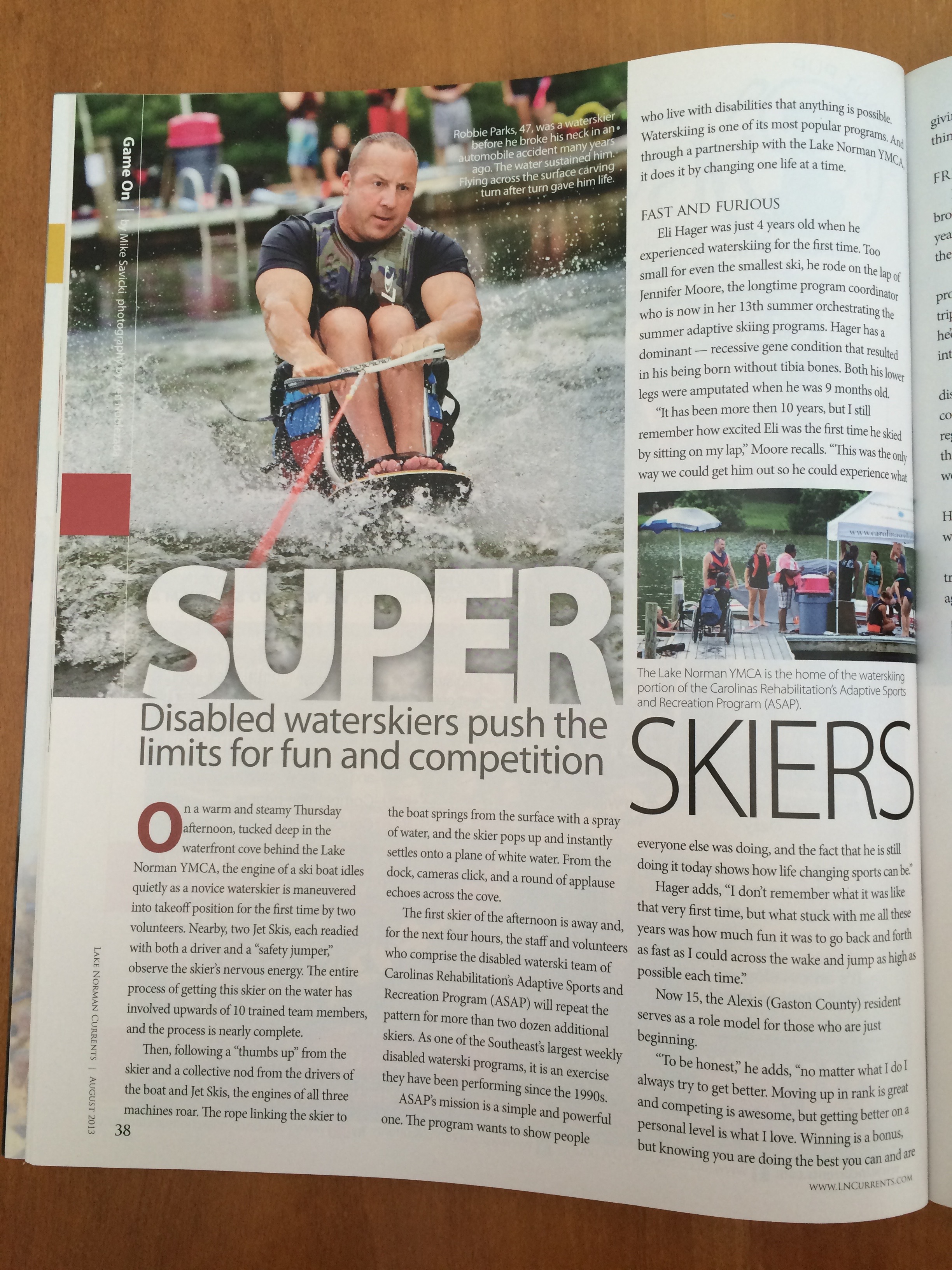Super Skiers
Disabled water skiers push the limits for fun and competition
By Mike Savicki
On a warm and steamy Thursday afternoon, tucked deep in the waterfront cove behind the Lake Norman YMCA, the engine of a ski boat idles quietly as a novice water skier is maneuvered into takeoff position for the first time by two volunteers. Nearby, two jet skis, each readied with both a driver and a “safety jumper,” observe the skier’s nervous energy. The entire process of getting this skier on the water has involved upwards of ten trained team members, and the process is nearly complete.
Then, following a “thumbs up” from the skier and a collective nod from the drivers of the boat and jet skis, the engines of all three machines roar. The rope linking the skier to the boat springs from the surface with a spray of water, and the skier pops to the surface and instantly settles onto a plane of whitewater. From the dock, cameras click and a round of applause echoes across the cove.
The first skier of the afternoon is away and, for the next four hours, the staff and volunteers who comprise the disabled water ski team of Carolinas Rehabilitation’s Adaptive Sports and Recreation Program (ASAP) will repeat the pattern for more than two dozen additional skiers. As one of the Southeast’s largest weekly disabled waterski programs, it is an exercise they have been performing since the 1990’s.
ASAP’s mission is a simple and powerful one. They want to show people who live with disabilities that anything is possible. Although water skiing is one of their most popular programs, they also offer sports like hand cycling, wheelchair rugby, tennis and even adaptive yoga. By getting individuals who live with disabilities involved in these, and letting them see their abilities instead of their disabilities – what they can vs. cannot do – they are changing lives. Their mission is further reinforced through a partnership with the lake Norman YMCA, where they are continuing to change one life at a time.
Fast and furious
Eli Hager was just four years old when he experienced water skiing for the first time. Too small for even the smallest ski, he rode on the lap of Jennifer Moore, the longtime program coordinator who is now in her 13th summer orchestrating what has grown into one of the Southeast’s largest summer adaptive skiing programs. Hager has a dominant – recessive gene condition that resulted in his being born without tibia bones. Both his lower legs were amputated when he was nine months old.
“It has been more than ten years, but I still remember how excited Eli was the first time he skied by sitting on my lap,” Jennifer Moore reflects. “This was the only way we could get him out so he could experience what everyone else was doing, and the fact that he is still doing it today shows how life-changing sports can be.”
Eli Hager adds, “I don’t remember what it was like that very first time, but what stuck with me all these years was how much fun it was to go back and forth as fast as I could across the wake and jump as high as possible each time.”
Now 15, the Alexis resident serves as a role model for those who are just beginning.
“To be honest,” he adds, “no matter what I do, I always try to get better. Moving up in rank is great and competing is awesome, but getting better on a personal level is what I love. Winning is a bonus, but knowing you are doing the best you can and are giving it your everything, that’s my reward, and I think people see that.”
Freedom to fly again
Robbie Parks, 47, was a water skier before he broke his neck in an automobile accident many years ago. The water sustained him. Flying across the surface carving turn after turn gave him life.
In the 1990’s, when the ASAP water ski program was in its infancy, Parks made his first trip to the lake to try the sport he never thought he’d be able to enjoy again. He transferred into a sit ski, grabbed the rope and gave it a try.
But after a few sessions, he felt more disappointment than enjoyment. A personal commitment kept him from coming back regularly, so the Lexington resident says he left at the end of the first summer not convinced that he would return.
In 2004, Parks decided to give it another try. He says he began feeling the pull to get on the water again.
Robbie Parks shares, “Those first summers back, it was just about trying it out and getting comfortable in the water again. I worked through a lot, and skiing became fun again.
He continues, “I made a big jump in 2007. By the end of that summer I was getting pretty good and someone asked me if I ever thought about doing this competitively. That’s when I realized I could get where I wanted to be. That was the spark I needed.”
Just days after being handed the phone number of America’s most recognized and respected disabled World Champion, Bill Boness, Parks was in Mississippi training to compete at an international level.
“I rediscovered the freedom that comes with being on the water,” Parks, now a USA Waterski certified coach, instructor and official, says with a smile. “The one thing I missed the most was not being able to ski, so to be able to get back on the water helps me feel like a kid again.”
Hager and Parks are two of the three ASAP skiers (Charlotte’s Megan McCauley is the third) who have ascended the competitive and will travel to Milan, Italy, later this summer to compete in the 2013 World Disabled Waterski Championships. All three will ski against the world’s best in the slalom, trick and jump events in different sit ski classes.
“I think all ASAP does is strive to introduce people to new opportunities – we like to be the first ones to help a person with a disability try a new sport – and because of that, it is so rewarding to see people take that next step and try something they never thought might be possible,” Jennifer Moore explains. “Eli and Robbie are great examples of showing people what is possible. As for me, seeing skiers learn and progress, and watching them as they gain back their self-confidence, that’s what has kept me doing this for so long, and that’s what makes me feel so great about everything we do.”
This article was originally published in the August 2013 edition of Currents Magazine.

